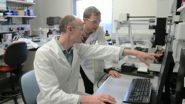(Press-News.org) CAMBRIDGE, MA -- Among the sciences, biology consistently attracts the greatest numbers of women to graduate school and academic careers. About half of all biology graduate students are women, and 40 percent of biology postdocs are female. However, those numbers drop dramatically among faculty members: Nationwide, only 36 percent of assistant professors and 18 percent of full professors are women.
A new study reveals a possible explanation for this discrepancy: In the labs of the highest-achieving male biology professors — winners of the Nobel Prize, the National Medal of Science, and other prestigious awards — women are greatly underrepresented, compared with their overall percentages in the field. Those labs serve as a major pipeline to junior faculty positions at top research institutions, the study found.
"What we found is that these labs really function as a gateway to the professoriate. So we think the fact that they're not hiring very many women is important for understanding why there are still so few female faculty members," says Jason Sheltzer, a graduate student in biology at MIT and author of the study, which appears this week in the Proceedings of the National Academy of Sciences.
Bringing attention to this imbalance offers an opportunity for faculty members and institutions to try to remedy the situation, says Angelika Amon, the Kathleen and Curtis Marble Professor in Cancer Research in MIT's Department of Biology, who is Sheltzer's PhD thesis advisor but was not involved in this study.
"Once you know what the problem is, you can actually do something about it. It's a great opportunity for these highly accomplished scientists to really reach out and make a very conscious effort to do something about the gender landscape of science at high-powered research institutions," Amon says. "A large segment of the population is being excluded from doing high-level research, and that can never be a good thing. We're losing out on bright and intelligent people."
'A very different picture'
Sheltzer and the paper's other author, Joan Smith, a software engineer and 2013 MIT graduate, studied the nation's top 24 biology research institutions, as ranked by U.S. News and World Report. They focused on programs such as cell biology, molecular biology, genetics, and biochemistry, which typically attract many women. From individual lab web sites or departmental directories, they were able to determine the number of male and female postdocs and grad students in the labs of 2,062 faculty members.
In labs run by female professors, women made up 53 percent of grad students and 46 percent of postdocs. Labs run by men had 47 percent female grad students and 36 percent female postdocs.
These gender differences became much more striking when the researchers analyzed the numbers from the labs of "elite" faculty members, which included members of the National Academy of Sciences, Howard Hughes Medical Institute (HHMI) investigators, and winners of seven different major research awards, including the Nobel Prize.
In the labs of male Nobel laureates, male grad students outnumbered female grad students by two to one, and male postdocs outnumbered female postdocs by more than three to one. In the labs of male HHMI investigators, only 31 percent of postdocs were female, compared with 38 percent for all other male professors.
"Looking at this small subset of labs, you get a very different picture than you do when you look at the field as a whole," Sheltzer says.
However, Sheltzer and Smith found no such imbalances in labs run by elite female faculty members. Female HHMI investigators ran labs with 48 percent female postdocs, compared with 46 percent in labs run by other female scientists.
The study did not explore the reasons for these discrepancies, but Sheltzer offers some possible explanations. "There is a chance that self-selection among female students plays a role — maybe there are fewer applications to these labs from women. In addition to that, there could be conscious or unconscious gender bias on the part of male faculty members, which makes them more reluctant to hire women," he says.
The application process for grad students or postdocs to work in a particular lab is informal: Usually an applicant emails the lab's principal investigator to inquire about openings, and there are no official records of how many people apply to work in a particular lab. Analyzing this application process more closely might help institutions figure out whether they should devote more effort to making labs more welcoming to female scientists and recruiting women more actively, the researchers say.
Explaining the leaky pipeline
Between 1969 and 2009, the percentage of doctoral degrees awarded to women in the life sciences grew from 15 percent to 52 percent, but women still lag when it comes to faculty appointments. The MIT team believes the new study helps to explain this attrition, known as the "leaky pipeline" problem.
Labs run by high-achieving professors usually have more funding available, more high-profile publications, and better connections with other top researchers, all of which can help young scientists from those labs when applying for scarce faculty positions. At top research institutions, there are typically dozens or even hundreds of applicants for every tenure-track faculty opening.
In this study, the researchers analyzed the employment history of 311 of the assistant professors working at the top 24 research institutions. Of these, 144 had completed a postdoctoral fellowship in one of the labs the researchers surveyed. The researchers found that the principal investigators of the "feeder" labs that produced these top job candidates were much more likely to have markers of elite status. For example, while only 13 percent of the total labs were run by National Academy of Science members, 58 percent of feeder labs were run by those individuals. Overall, the feeder labs employed 14 percent fewer female postdocs than nonfeeder labs.
INFORMATION:
Research reveals a gender gap in the nation's biology labs
2014-07-01
ELSE PRESS RELEASES FROM THIS DATE:
Study reveals that many people are oblivious to how they come across to counterparts and colleagues
2014-07-01
NEW YORK—Jill Abramson was recently ousted from her position as the executive editor of The New York Times for being, among other things, too "pushy." But did Abramson—who has also been described by the media as "polarizing" and "brusque"—know during the course of her tenure that others viewed her as being overly assertive? A new study from the Columbia Business School suggests that there's a great chance she didn't.
"Finding the middle ground between being pushy and being a pushover is a basic challenge in social life and the workplace. We've now found that the challenge ...
All the world's oceans have plastic debris on their surface
2014-07-01
However, central surface waters of the oceans may not be the final destination of plastic debris since, as indicated by the study performed by the Malaspina Expedition, large amounts of microplastics could be passing to the marine food chain and the ocean floor. Results of the study, led by the University of Cadiz (Spain), have been published in the journal Proceedings of the National Academy of Sciences (PNAS).
Andrés Cózar, researcher from the University of Cadiz, explains: "Ocean currents carry plastic objects which split into smaller and smaller fragments due to solar ...
Genetic evidence that body mass increases the risk of asthma in mid-childhood
2014-07-01
Some of the increase in asthma risk toward the end of the 20th century could be attributed to the increase in body mass index (BMI) in mid-childhood, according to new research published in this week's PLOS Medicine. The study, led by Raquel Granell from the University of Bristol, UK, and colleagues, provides genetic evidence that higher fat mass and lean mass increase the risk of asthma in mid-childhood.
The incidence of asthma, a chronic condition caused by inflammation of the airways, has been rising steadily over the past few decades, and it is estimated that 200� ...
Cesarean section linked to slight increase in future stillbirth and ectopic pregnancy
2014-07-01
Caesarean section is associated with a slightly increased rate of subsequent stillbirth and ectopic pregnancy, according to a large study of women living in Demark, published in this week in PLOS Medicine. Given the global increase in Caesarean rates, the results of the study, which was conducted by Louise Kenny and colleagues from University College Cork, Ireland and Aarhus University, Denmark, are of interest to pregnant women, their partners, and healthcare providers.
The researchers obtained data for 832,996 women from Danish national registers regarding their first ...
Catheter ablation a first-line treatment for atrial flutter
2014-07-01
Use of catheter ablation is not only beneficial for treating atrial flutter but also can significantly reduce hospital visits – both inpatient and emergency – and lower the risk for atrial fibrillation, according to research by UC San Francisco.
The study is in the July issue of PLOS ONE and available online.
"We've seen firsthand in our clinical experience that atrial flutter is difficult to control with drugs, even more than atrial fibrillation," said senior author Gregory Marcus, MD, director of clinical research in the UCSF Division of Cardiology. "Based on our ...
New insights from the modENCODE Project are published in Genome Research
2014-07-01
July 1, 2014 – Genome Research publishes six articles online and in print today describing recent advancements from the modENCODE Project. Initially launched in 2007, the goal of the modENCODE Project is to comprehensively characterize functional genomic elements in two model organisms, the fly Drosophila melanogaster, and the worm Caenorhabditis elegans. Comparative analyses in these well-established systems are expected to guide efforts to further our understanding of human biology. The articles published in this issue present new genomic advances shedding light upon ...
New compound blocks 'gatekeeper' enzyme to kill malaria
2014-07-01
VIDEO:
Melbourne researchers are homing in on a new target for malaria treatment, after developing a compound that blocks the action of a key 'gatekeeper' enzyme essential for malaria parasite survival.
The...
Click here for more information.
Melbourne researchers are homing in on a new target for malaria treatment, after developing a compound that blocks the action of a key 'gatekeeper' enzyme essential for malaria parasite survival.
The compound, called WEHI-916, is ...
Analysis of the Chinese facial profile: Contours of the side face in the Tu and Zang ethnic minorities
2014-07-01
Li Haijun and fellow researchers at Minzu University of China, in Beijing, conducted a series of geometric morphometric analyses of the contours of the side face and variations in the Tu and Zang (Tibetan) ethnic minorities from Qinghai Province, in northwestern China.
Their study, entitled "Morphometric analysis of the Chinese facial profile: Contours of the side face and variations in the Tu and Zang ethnic minorities", was published (in Chinese) in the Chinese Science Bulletin, 2014, Vol 59(16).
The team of researchers used advanced digital cameras and image processing ...
Behind a marine creature's bright green fluorescent glow
2014-07-01
Pushing closer to understanding the mechanisms behind the mysterious glow of light produced naturally by certain animals, scientists at Scripps Institution of Oceanography at UC San Diego have deciphered the structural components related to fluorescence brightness in a primitive sea creature.
In a study published in Scientific Reports, an open-access journal of the Nature Publishing Group, Dimitri Deheyn and his colleagues at Scripps Oceanography, the Air Force Research Laboratory, and the Salk Institute for Biological Studies have conducted the most detailed examination ...
Solar panels light the way from carbon dioxide to fuel
2014-07-01
Research to curb global warming caused by rising levels of atmospheric greenhouse gases, such as carbon dioxide, usually involves three areas: Developing alternative energy sources, capturing and storing greenhouse gases, and repurposing excess greenhouse gases. Drawing on two of these approaches, researchers in the laboratory of Andrew Bocarsly, a Princeton professor of chemistry, collaborated with start-up company Liquid Light Inc. of Monmouth Junction, N.J. to devise an efficient method for harnessing sunlight to convert carbon dioxide into a potential alternative fuel ...

